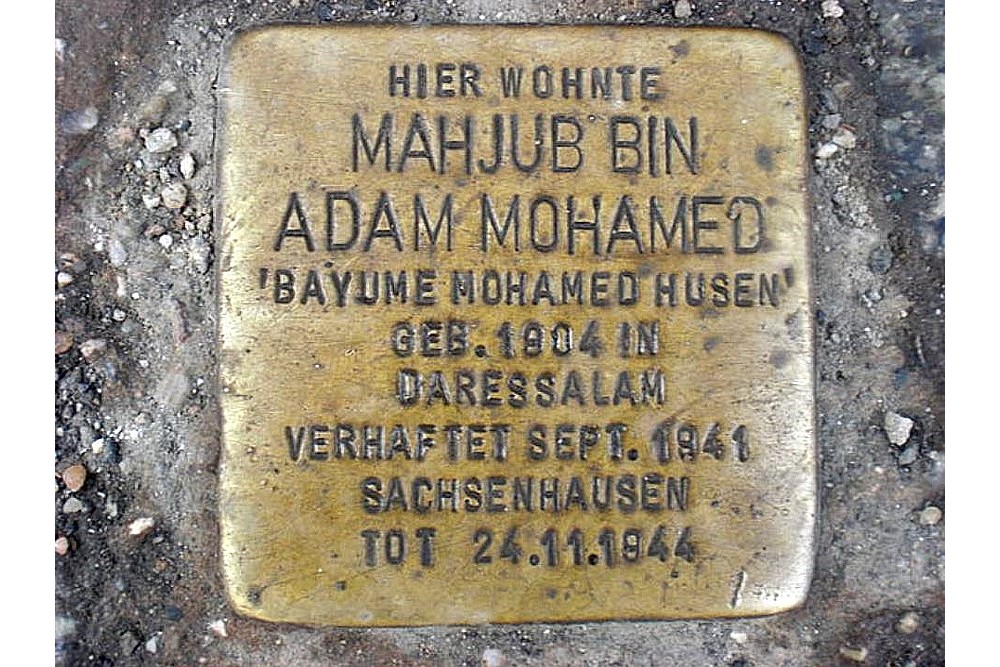Stumbling Stone Brunnenstraße 193
This small, brass, memorial plaque (Stolperstein or stumbling stone) commemorates
* Mahjub bin Adam Mohamed, ‘Bayume Mohamed Husen,’ born 1904 in Daressalam, arrested Sept. 1941, Sachsenhausen, dead 24 November 1944.
In September 2007, this stolperstein was installed for Mahjub bin Adam Mohamed. It was the first stolperstein to memorialize an African victim of the Nazis.
Mahjub bin Adam Mohamed was born in Dar es Salaam, German East Africa. At age 10, he joined his father to serve in WWI as child soldier. After the war and after his homeland became British Tanganyika, he worked as a steward on a German ship, then ended up in Berlin in 1929. There he became known as Bayume Mohamed Husen. With help from his German contacts, he found work as an "exotic" waiter at the "Haus Vaterland" (a large entertainment center) while also teaching Kiswahili at the University of Berlin. He was active in the movement to return former German colonies to German rule. He also worked as an actor: from 1934 on, he had roles in 23 films, including in one where he acted his life experience as a child soldier.
Husen’s personal life included fathering two children by two different German women. In 1933 (the year both children were born), he married one of the women, Maria Schwander, and adopted Heinz Bodo, the son of the other. Both of his children with Maria Schwander died around the time of the outbreak of WW2.
Husen did not have full German citizenship. Even that status was revoked, and he was considered to be a citizen of the British, who had taken over the German colony. His "alien" passport had to be renewed every year. One year he was late, and was convicted of passport fraud.
Husen tried without success to claim his outstanding pay for WW1 service. He applied more than once for the medal he deserved in recognition of his WW1 service as a combattant. Finally, the decision was made that the medal was only for white soldiers. (But he bought one in a shop and had photographs of himself proudly wearing it.) Still considering himself a loyal German, in 1939, he applied to join the Wehrmacht. He was refused.
Sources differ in the timing of the charges of miscegenation. One source states that in 1935 a fellow waiter denounced him, and Husen sued his employer, Kempinski, for "unfair dismissal." Another source says he was denounced in 1941 for miscegenation. The authorities knew him as a troublemaker – as someone who fought for his rights. In addition, none of his contacts at the university or in the colonial movement defended him. In September 1941, Bayume Mohamed Husen was imprisoned without trial in Sachsenhausen, where he managed to survive for 3 years.
"Stolpersteine" is an art project for Europe by Gunter Demnig to commemorate victims of National Socialism (Nazism). Stolpersteine (stumbling stones) are small, 10x10cm brass plaques placed in the pavement in front of the last voluntary residence of (mostly Jewish) victims who were murdered by the Nazis. Each plaque is engraved with the victim’s name, date of birth, and place (mostly a concentration camp) and date of death. By doing this, Gunter Demnig gives an individual memorial to each victim. One stone, one name, one person. He cites the Talmud: "A human being is forgotten only when his or her name is forgotten."
Do you have more information about this location? Inform us!
Source
- Text: Fedor de Vries & Anne Palmer
- Photos: Augustin berlin
- Stolpersteine in Berlin: Mahjub bin Adam Mohamed
- International Encyclopedia of the First World War: Husen, Bayume Mohamed
- Stolpersteine.eu
Nearby
Museum
- Anne Frank Centre - Berlin
- Otto Weidt’s Workshop for the Blind - Berlin
- German Historical Museum (Zeughaus Berlin) - Berlin
Point of interest
- Bullet Impacts Große Hamburger Straße 28 - Berlin
- New Synagogue - Berlin
- Former Gestapo Office Berlin - Berlin
Monument
- The Deserted Room (Der Verlassene Raum) - Berlin
- Memorial Sala and Martin Kochmann - Berlin-Mitte
- Memorial Selmar Kaufmann - Berlin-Mitte
Cemetery
- Jewish Cemetery Schönhauser Allee - Berlin
- German War Graves Dorotheenstädtischer Friedhof - Berlin
- Mass Grave Germans Domfriedhof I - Berlin
Remembrance Stone
- Stumbling Stone Brunnenstraße 194 - Berlin-Mitte
- Stumbling Stones Brunnenstraße 195 - Berlin-Mitte
- Stumbling Stone Brunnenstraße 14 - Berlin-Mitte





